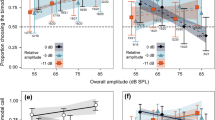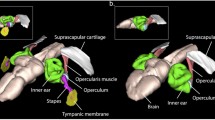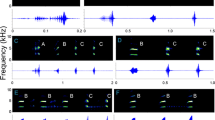Abstract
Advertisement calls, auditory tuning, and larynx and ear morphology were examined in 3 neotropical frogs, Hyla microcephala, H. phlebodes and H. ebraccata, H. microcephala has the highest call dominant frequency (6.068 kHz) and basilar papilla tuning (5.36 kHz). H. phlebodes and H. ebraccata calls have lower dominant frequencies (3.832 and 3.197 kHz respectively) and basilar papilla tuning (2.79 and 2.56 kHz). The primary call notes of H. ebraccata are longer (181.6 ms) than those of H. microcephala (95.5 ms) or H. phlebodes (87.3 ms). Morphometric analysis suggests that temporal call features differ as laryngeal musculature changes, in the process changing the overall size of the larynx. The spectral aspects of the call differ as head size, and hence the size of its resonating and radiating structures, changes, modifying the dominant frequency of calls by accentuating their higher harmonics when head size decreases. Decreasing head size decreases the size of the middle and inner ear chambers, changing the mechanical tuning of the ear in the same direction as the change in dominant frequency. These changes result in divergent spectral-temporal characteristics of both the sending and receiving portions of the acoustic communication system underlying social behavior in these frogs.
Similar content being viewed by others
Abbreviations
- AP:
-
amphibian papilla
- BEF:
-
best excitatory frequency
- BP:
-
basilar papilla
- dB SPL:
-
decibels sound pressure level re:20 μN/m2
References
Blair F (1958) Mating call in the speciation of anuran amphibians. Am Nat 92:27–31
Capranica RR, Moffat AJM (1983) Neurobehavioral correlates of sound communication in anurans. In: Ewert J-P, Capranica RR, Ingle D (eds) Advances in vertebrate neuroethology. Plenum Press, New York, pp 701–730
Condon CJ, Chang S-H, Feng AS (1991) Processing of behaviorally relevant temporal parameters of acoustic stimuli by single neurons in the superior olivary nucleus of the leopard frog. J Comp Physiol A 168:709–725
Drewry GE, Rand AS (1983) Characteristics of an acoustic community: Puerto Rican frogs of the genus Eleutherodactylus. Copeia 1983:941–953
Duellman WE (1970) The hylid frogs of Middle America. Univ Kansas Mus Nat History Monographs, Lawrence
Duellman WE, Pyles RA (1983) Acoustic resource partitioning in anuran communities. Copeia 1983:639–649
Eggermont JJ (1988) Mechanisms of sound localization in anurans. In: Fritzsch B, Ryan MJ, Wilczynski W, Hetherington TE, Walkowiak W (eds) The evolution of the amphibian auditory system. John Wiley & Sons, New York, pp 307–336
Feng AS, Hall JC, Gooler DM (1990) Neural basis of sound pattern recognition in anurans. Prog Neurobiol 34:313–329
Fouquette MJ (1960) Isolating mechanisms in three sympatric tree frogs in the Canal Zone. Evolution 14:484–497
Fox JH (1991) Morphological correlates of auditory sensitivity in anuran amphibians. Soc Neurosci Abstr 17:1403
Gerhardt HC (1988) Acoustic properties used in call recognition by frogs and toads. In: Fritzsch B, Ryan MJ, Wilczynski W, Hetherington TE, Walkowiak W (eds) The evolution of the amphibian auditory system. John Wiley & Sons, New York, pp 455–484
Hall JC, Feng AS (1987) Evidence for parallel processing in the frog's auditory thalamus. J Comp Neurol 258:407–419
Hetherington TE (1992a) The effects of body size on functional properties of middle ear systems of anuran amphibians. Brain Behav Evol 39:133–142
Hetherington TE (1992b) The effects of body size on the evolution of the amphibian middle ear. In: Webster DB, Fay RR, Popper AN (eds) The evolutionary biology of hearing. Springer, Berlin Heidelberg New York, pp 421–437
Humason GL (1972) Animal tissue techniques. WH Freeman, San Francisco
Jaslow AP, Hetherington TE, Lombard RE (1988) Structure and function of the amphibian middle ear. In: Fritzsch B, Ryan MJ, Wilczynski W, Hetherington TE, Walkowiak W (eds) The evolution of the amphibian auditory system. John Wiley & Sons, New York, pp 69–91
Lewis ER, Lombard RE (1988) The amphibian inner ear. In: Fritzsch B, Ryan MJ, Wilczynski W, Hetherington TE, Walkowiak W (eds) The evolution of the amphibian auditory system. John Wiley & Sons, New York, pp 93–123
Littlejohn MJ (1988) Frog calls and speciation: The retrograde evolution of homogametic acoustic signaling systems in hybrid zones. In: Fritzsch B, Ryan MJ, Wilczynski W, Hetherington TE, Walkowiak W (eds) The evolution of the amphibian auditory system. John Wiley & Sons, New York, pp 613–636
Littlejohn MJ, Martin AA (1969) Acoustic interaction between two species of leptodactylid frogs. Anim Behav 17:785–791
Loftus-Hills JJ (1973) Comparative aspects of auditory function in Australian anurans. Aust J Zool 21:353–367
Martin WF (1972) Evolution of vocalizations in the genus Bufo. In: Blair WF (ed) Evolution in the genus Bufo. Univ of Texas Press, Austin, pp 279–309
McClelland BE, Wilczynski W (1989) Sexually dimorphic laryngeal morphology in Rana pipiens. J Morphol 201:293–299
McClelland BE, Wilczynski W, Ryan MJ (1993) Call characteristics and the morphology of the larynx and ear in cricket frogs (Acris crepitans). J Morphol (submitted)
Narins PM (1983) Divergence of acoustic communication systems of two sibling species of eleutherodactylid frogs. Copeia 1983:1089–1090
Narins PM, Zelick RD (1988) The effects of noise on auditory processing and behavior in amphibians. In: Fritzsch B, Ryan MJ, Wilczynski W, Hetherington TE, Walkowiak W (eds) The evolution of the amphibian auditory system. John Wiley & Sons, New York, pp 511–536
Plassmann W, Brandle K (1992) A functional model of the auditory system in mammals and its evolutionary implications. In: Webster DB, Fay RR, Popper AN (eds) The evolutionary biology of hearing. Springer, Berlin Heidelberg New York, pp 637–653
Rand AS (1988) An overview of anuran acoustic communication. In: Fritzsch B, Ryan MJ, Wilczynski W, Hetherington TE, Walkowiak W (eds) The evolution of the amphibian auditory system. John Wiley & Sons, New York, pp 415–432
Rose GJ, Capranica RR (1984) Processing of amplitude-modulated sounds by the auditory midbrain of two species of toads: matched temporal filters. J Comp Physiol A 154:211–219
Rose GJ, Brenowitz EA, Capranica RR (1985) Species specificity and temperature dependency of temporal processing by the auditory midbrain of two species of treefrogs. J Comp Physiol A 157:763–769
Ryan MJ (1988) Constraints and patterns in the evolution of anuran acoustic communication. In: Fritzsch B, Ryan MJ, Wilczynski W, Hetherington TE, Walkowiak W (eds) The evolution of the amphibian auditory system. John Wiley & Sons, New York, pp 637–678
Ryan MJ, Drewes RC (1990) Vocal morphology of Physalaemus pustulosus species group (Leptodactylidae): morphological response to sexual selection for complex calls. Biol J Linn Soc 40:37–52
Ryan MJ, Wilczynski W (1991) Evolution of intraspecific variation in the advertisement call of a cricket frog (Acris crepitans, Hylidae). Biol J Linn Soc 44:249–271
Sassoon D, Kelley D (1986) The sexually dimorphic larynx of Xenopus laevis: Development and androgen regulation. Am J Anat 177:457–472
Schmid E (1977) The vocal apparatus of Bombina bombina (L.), Bombina v. variegata (L.) and Alytes o. obstetricans (LAUR). Zool Jb Anat 98:133–150
Schmidt RS (1972) Action of intrinsic laryngeal muscles during release calling in leopard frogs. J Exp Zool 181:233–244
Schneider H (1988) Peripheral and central mechanisms of vocalization. In: Fritzsch B, Ryan MJ, Wilczynski W, Hetherington TE, Walkowiak W (eds) The evolution of the amphibian auditory system. John Wiley & Sons, New York, pp 537–558
Schwartz JJ (1987) The importance of spectral and temporal properties in species and call recognition in a neotropical treefrog with a complex vocal repertoire. Anim Behav 35:340–347
Schwartz JJ (1991) Why stop calling? A study of unison bout singing in a neotropical treefrog. Anim Behav 42:565–577
Schwartz JJ, Wells KD (1983) An experimental study of acoustic interference between two species of neotropical treefrogs. Anim Behav 31:181–190
Schwartz JJ, Wells KD (1984a) Vocal behavior of the neotropical treefrog Hyla phlebodes. Herpetologica 40:452–463
Schwartz JJ, Wells KD (1984b) Interspecific acoustic interactions of the neotropical treefrog Hyla ebraccata. Behav Ecol Sociobiol 14:211–224
Schwartz JJ, Wells KD (1985) Intra- and inter-specific vocal behavior of the neotropical treefrog Hyla microcephala. Copeia 1985:27–38
Walkowiak W (1988) Central temporal coding. In: Fritzsch B, Ryan MJ, Wilczynski W, Hetherington TE, Walkowiak W (eds) The evolution of the amphibian auditory system. John Wiley & Sons, New York, pp 275–294
Wells KD (1977) The social behavior of anuran amphibians. Anim Behav 25:666–693
Wells KD (1988) The effect of social interactions on anuran vocal behavior. In: Fritzsch B, Ryan MJ, Wilczynski W, Hetherington TE, Walkowiak W (eds) The evolution of the amphibian auditory system. John Wiley & Sons, New York, pp 433–454
Wells KD, Bard KM (1987) Vocal communication in a neotropical treefrog, Hyla ebraccata: Responses of females to advertisement and aggressive calls. Behaviour 101:200–210
Wells KD, Schwartz JJ (1984) Vocal communication in a neotropical treefrog, Hyla ebraccata: Advertisement calls. Anim Behav 32:405–420
Wells KD, Taigen TL (1989) Calling energetics of the neotropical treefrog Hyla microcephala. Behav Ecol Sociobiol 25:13–22
Wilczynski W, Brenowitz EA (1988) Acoustic cues mediate intermale spacing in a neotropical frog. Anim Behav 36:1054–1063
Wilczynski W, Capranica RR (1984) The auditory system of anuran amphibians. Prog Neurobiol 22:1–38
Wilczynski W, Zakon HH, Brenowitz EA (1984) Acoustic communication in spring peepers: Call characteristics and neurophysiological aspects. J Comp Physiol A 155:577–584
Wilczynski W, Resler C, Capranica RR (1987) Tympanic and extratympanic sound transmission in the leopard frog. J Comp Physiol A 161:659–669
Wilczynski W, Keddy-Hector AC, Ryan MJ (1992) Call differences and basilar papilla tuning in cricket frogs. I. Differences among populations and between sexes. Brain Behav Evol 39:229–237
Zakon HH, Wilczynski W (1988) The physiology of the anuran eighth nerve. In: Fritzsch B, Ryan MJ, Wilczynski W, Hetherington TE, Walkowiak W (eds) The evolution of the amphibian auditory system. John Wiley & Sons, New York, pp 125–155
Zelick R (1986) Jamming avoidance in electric fish and frogs. Strategies of signal oscillator timing. Brain Behav Evol 28:60–69
Zelick RD, Narins PM (1983) Intensity discrimination and the precision of call timing in two species of neotropical treefrogs. J Comp Physiol 153:403–412
Author information
Authors and Affiliations
Rights and permissions
About this article
Cite this article
Wilczynski, W., McClelland, B.E. & Rand, A.S. Acoustic, auditory, and morphological divergence in three species of neotropical frog. J Comp Physiol A 172, 425–438 (1993). https://doi.org/10.1007/BF00213524
Accepted:
Issue Date:
DOI: https://doi.org/10.1007/BF00213524




